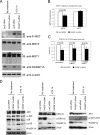The tumor suppressor RASSF1A prevents dephosphorylation of the mammalian STE20-like kinases MST1 and MST2
- PMID: 21199877
- PMCID: PMC3057778
- DOI: 10.1074/jbc.M110.178210
The tumor suppressor RASSF1A prevents dephosphorylation of the mammalian STE20-like kinases MST1 and MST2
Abstract
The RASSF1A tumor suppressor protein interacts with the pro-apoptotic mammalian STE20-like kinases MST1 and MST2 and induces their autophosphorylation and activation, but the mechanism of how RASSF1A activates MST1/2 is unclear. Okadaic acid treatment and PP2A knockdown promoted MST1/2 phosphorylation. Data from dephosphorylation assays and reduced activation of MST1/2 seen after RASSF1A depletion suggest that dephosphorylation of MST1/2 on Thr-183 and Thr-180 by PP2A is prevented by RASSF1A, shifting the balance of MST1/2 to the activated autophosphorylated form. In addition to preventing dephosphorylation, RASSF1A also stabilized the MST2 protein. Through binding to MST1/2, RASSF1A supports maintenance of MST1/2 phosphorylation, promoting an active state of the MST kinases and favoring induction of apoptosis. This is one of the first examples of a tumor suppressor acting as an inhibitor of a specific dephosphorylation pathway.
Figures





Similar articles
-
Okadaic Acid: a tool to study the hippo pathway.Mar Drugs. 2013 Mar 14;11(3):896-902. doi: 10.3390/md11030896. Mar Drugs. 2013. PMID: 23493077 Free PMC article. Review.
-
Role of the tumor suppressor RASSF1A in Mst1-mediated apoptosis.Cancer Res. 2006 Mar 1;66(5):2562-9. doi: 10.1158/0008-5472.CAN-05-2951. Cancer Res. 2006. PMID: 16510573
-
NDR kinase is activated by RASSF1A/MST1 in response to Fas receptor stimulation and promotes apoptosis.Curr Biol. 2008 Dec 9;18(23):1889-95. doi: 10.1016/j.cub.2008.10.060. Curr Biol. 2008. PMID: 19062280
-
Proapoptotic kinase MST2 coordinates signaling crosstalk between RASSF1A, Raf-1, and Akt.Cancer Res. 2010 Feb 1;70(3):1195-203. doi: 10.1158/0008-5472.CAN-09-3147. Epub 2010 Jan 19. Cancer Res. 2010. PMID: 20086174 Free PMC article.
-
MST1/MST2 Protein Kinases: Regulation and Physiologic Roles.Biochemistry. 2016 Oct 4;55(39):5507-5519. doi: 10.1021/acs.biochem.6b00763. Epub 2016 Sep 26. Biochemistry. 2016. PMID: 27618557 Free PMC article. Review.
Cited by
-
The cellular functions of RASSF1A and its inactivation in prostate cancer.J Carcinog. 2012;11:3. doi: 10.4103/1477-3163.93000. Epub 2012 Feb 17. J Carcinog. 2012. PMID: 22438769 Free PMC article.
-
Suppressor of hepatocellular carcinoma RASSF1A activates autophagy initiation and maturation.Cell Death Differ. 2019 Aug;26(8):1379-1395. doi: 10.1038/s41418-018-0211-7. Epub 2018 Oct 12. Cell Death Differ. 2019. PMID: 30315205 Free PMC article.
-
Resistance to Targeted Therapy and RASSF1A Loss in Melanoma: What Are We Missing?Int J Mol Sci. 2021 May 12;22(10):5115. doi: 10.3390/ijms22105115. Int J Mol Sci. 2021. PMID: 34066022 Free PMC article. Review.
-
Pathogenetic and Prognostic Significance of Inactivation of RASSF Proteins in Human Hepatocellular Carcinoma.Mol Biol Int. 2012;2012:849874. doi: 10.1155/2012/849874. Epub 2012 Apr 2. Mol Biol Int. 2012. PMID: 22548173 Free PMC article.
-
Dasatinib induces DNA damage and activates DNA repair pathways leading to senescence in non-small cell lung cancer cell lines with kinase-inactivating BRAF mutations.Oncotarget. 2016 Jan 5;7(1):565-79. doi: 10.18632/oncotarget.6376. Oncotarget. 2016. PMID: 26623721 Free PMC article.
References
-
- Dammann R., Li C., Yoon J. H., Chin P. L., Bates S., Pfeifer G. P. (2000) Nat. Genet. 25, 315–319 - PubMed
-
- Dammann R., Schagdarsurengin U., Seidel C., Strunnikova M., Rastetter M., Baier K., Pfeifer G. P. (2005) Histol. Histopathol. 20, 645–663 - PubMed
-
- Agathanggelou A., Cooper W. N., Latif F. (2005) Cancer Res. 65, 3497–3508 - PubMed
-
- Tommasi S., Dammann R., Zhang Z., Wang Y., Liu L., Tsark W. M., Wilczynski S. P., Li J., You M., Pfeifer G. P. (2005) Cancer Res. 65, 92–98 - PubMed
Publication types
MeSH terms
Substances
LinkOut - more resources
Full Text Sources
Molecular Biology Databases
Research Materials
Miscellaneous

